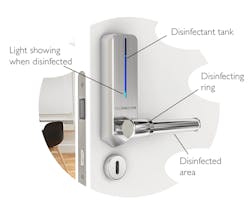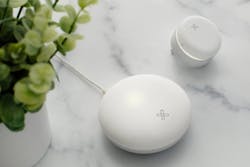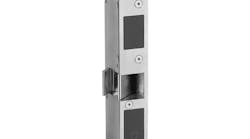This article originally appeared in the February 2021 issue of Security Business magazine. When sharing, don’t forget to mention @SecBusinessMag on Twitter and Security Business magazine on LinkedIn.
Welcome to our annual CES issue! As the only security industry magazine/website dedicated to fully covering a show focused on cutting-edge consumer tech, we believe that these innovations not only give security industry practitioners, integrators and developers a look at the current smart home and cybersecurity landscape, but they also give us a glimpse into the future of where our technology is headed.
Utilimedic, a division of vehicle technology company Namsung America, demoed its UV8LED, an in-car phone sanitizer with wired and wireless charging. This UV light sanitation device can be plugged into a vehicle’s 12V socket and mounts on a dashboard. For our industry, think about how this might be valuable to a security technician or salesperson who, for example, needs to use a phone or small tablet to obtain customer signatures or payments.
In the door hardware realm, CleanMotion, a Swiss start-up (https://cleanmotion.ch), gave me a look at its “immediate self-disinfecting door handle” – which disinfects a door handle after every touch. The user loads a compartment (located where the battery holder or the pushbutton panel would be on a traditional smart lock) with the disinfectant, a sensor determines when the handle is released, which activates a disinfectant ring that moves up and down along the surface, eliminating 99.9% of bacteria by spreading the sanitizer. Sounds like a high-tech way to bring a low-tech version of an anti-microbial coating (they can’t all be winners).
Future Tech: Wi-Fi Sensing
The rise of ultra-fast Wi-Fi 6 has opened up possibilities for expanded security technologies in the home. In a report prepared for NXP Semiconductor, Andrew Zignani, Principal Analyst for ABI Research’s Strategic Technologies team, says: “New enhancements to Wi-Fi technology, such as Wi-Fi 6 and 6E, can help better serve a mixture of device types, from high-throughput video applications, such as smart TVs, AR/ VR, voice assistants, and IP cameras, to low-cost and power-sensitive sensor and monitoring devices, as well as a whole host of other devices ranging from thermostats and smart lighting to other connected home devices.”
One company I saw at CES takes this prediction to heart, and in fact, presented an intrusion/occupancy detection system based completely on “Wi-Fi Sensing technology.”
In 2013, in collaboration with University of Maryland research, Origin Wireless AI discovered that Wi-Fi could be used for sensing by calculating how Wi-Fi“Origin realized it could protect an entire home with just a few Wi-Fi devices,” a product release says. “This led to the creation of Hex – a simple to use, extremely accurate home security system that is solving some of the biggest challenges in the security industry.”
I attended a virtual demo of the product. The company claims it reduces false alarms and provides room occupancy detection in non-alarm mode. It certainly works well for “alarm away” situations, but so far has no adaptability to “alarm stay” mode – something that many users deploy, especially with so many at home all the time right now (personally, my alarm system is most valuable when I am home sleeping). Still, I would expect that Wi-Fi sensing is another budding technology about to be harnessed by more in our industry.
In addition to the great CES content included in this issue, I encourage you to embrace the possibilities by checking out our full coverage at www.securityinfowatch.com/ces.
Paul Rothman is Editor-in-Chief of Security Business magazine (www.securitybusinessmag.com). Email him your comments or topic suggestions at [email protected].




